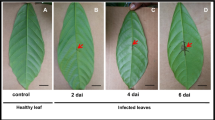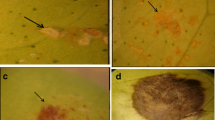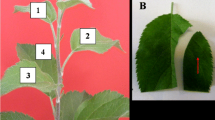Abstract
The study was carried out on phytoplasma susceptible grapevine variety ‘Chardonnay’ (Vitis vinifera L.). The changes in total and individual phenolics, with a focus on hydroxycinnamic acids, flavanols and flavonol contents, were studied in phytoplasma-symptomatic and non-symptomatic berries of Bois noir (BN) infected and uninfected vines. Evident responses to BN infection at veraison have been monitored in a decreased accumulation of caftaric and coutaric acids, p-coumaroyl hexose, procyanidin B1, procyanidin trimer as well as of quercetin-3-O-glucoside, quercetin-3-O-glucuronide and quercetin-3-O-xyloside. At berry softening BN infection statistically increased the content of total phenolics, hydroxycinnamic acids and flavanols, but decreased the flavonol contents, especially at phytoplasma-symptomatic berry skins. Later, at harvest, the BN infection caused an additional significant decrease of coutaric acid and p-coumaroyl pentose contents, moreover of procyanidin B1 and procyanidin dimmers (1, 2, and 3), trimer, kaempferol-3-O-glucoside and of most identified quercetins, except of quercetin-3-O-xyloside. At harvest, non-symptomatic berries from infected plants showed similar dynamics in the total phenolic content compared to berry skins from uninfected plants, but in total flavanols and flavonols content similarity to those symptomatic was observed. The latter decreases grape quality and its antioxidant potential. The Bois noir disease showed specific, local and growth-phase-induced responses regarding the content of phenolics in berry skins, where in particular the differences between phytoplasma-symptomatic and non-symptomatic grapes have to be underlined.

Similar content being viewed by others
Abbreviations
- BN:
-
bois noir
- HLT:
-
healthy (non infected)
- INF:
-
infected (bois noir)
- INFWS:
-
infected without symptom
- BBCH:
-
Biologische Bundesanstalt Bundessortenamt und Chemische Industrie
References
Alexander, M. (1965). Biodegradation: problems of molecular recalcitrance and microbial infallibility. Advances in Applied Microbiology, 7, 35–80.
Bavaresco, L., Petegolli, D., Cantu, E., Fregoni, M., Chiusa, G., & Trevisan, M. (1997). Elicitation and accumulation of stilbene phytoalexins in grapevine berries infected by Botrytis cinerea. Vitis, 36, 77–83.
Blanchfield, A. L., Robinson, S. A., Renzullo, L. J., & Powell, K. S. (2006). Phylloxera-infested grapevines have reduced chlorophyll and increased photoprotective pigment content – can leaf pigment composition aid pest detection? Functional Plant Biology, 33, 507–514.
Boudon-Padieu, E. (2003). The situation of grapevine yellows and current research directions: Distribution, diversity, vectors, diffusion and control. Extended abstracts of the 14th Meeting of ICVG, Locorotondo (Bari), Italy, September 2003, pp 47–53.
Castillo-Muñoz, N., Gomez-Alonso, S., Garcia-Romero, E., & Hermosin-Gutierrez, I. (2010). Flavonol profiles of Vitis vinifera white grape cultivars. Journal of Food Composition and Analysis, 23, 699–705.
Cheynier, V. (2000). Grape polyphenolics and their reactions in wine. In S. Martens, D. Treutter, & G. Forkmann (Eds.), Polyphenolics 2000 (pp. 1–14). Germany: Freising-Weihenstephan.
De Freitas, V. A. P., Glories, Y., & Monique, A. (2000). Developmental changes of procyanidins in grapes of red Vitis vinifera varieties and their composition in respective wines. American Journal of Enology and Viticulture, 51, 397–403.
Fernández-Zurbano, P., Ferreira, V., Escudero, A., & Cacho, J. (1998). Role of hydroxycinnamic acids and flavanols in the oxidation and browning of white wines. Journal of Agriculture and Food Chemistry, 46, 4937–4944.
Ferri, M., Righetti, L., & Tassoni, A. (2011). Increasing sucrose concentration promote phenylpropanoid biosynthesis in grapevine cell cultures. Journal of Plant Physiology, 168, 189–195.
Figueiredo, A., Fortes, A. M., Ferreira, S., Sebastiana, M., Choi, Y. H., Sousa, L., et al. (2008). Transcriptional and metabolic profiling of grape (Vitis vinifera L.) leaves unravel possible innate resistance against pathogenic fungi. Journal of Experimental Botany, 59, 3371–3381.
Garau, R., Sechi, A., Prota, V. A., & Moro, G. (2007). Productive parameters in Chardonnay and Vermentino grapevines infected with “bios noir” and recovered in Sardinia. Bulletin of Insectology, 60, 233–234.
Geny, L., Darrieumerlou, A., & Doneche, B. (2003). Conjugate polyamines and hydroxycinnamic acids in grape berries during Botrytis cinerea disease development: differences between ‘noble rot’ and ‘grey mould’. Australina Journal of Grape and Wine Research, 9, 102–106.
Gómez-Míguez, M. J., Gonzáles-Miret, M. L., Hernanz, D., Fernández, M. A., Vicario, I. M., & Heredia, F. J. (2007). Effects of prefermentative skin contact conditions on colour and phenolic content of white wines. Journal of Food Engineering, 78, 238–245.
González-Manzano, S., Rivas-Gonzalo, J. C., & Santos-Buelga, C. (2004). Extraction of flavan-3-ols from grape seed and skin into wine using simulated maceration. Analytica Chimica Acta, 513, 283–289.
Gutha, L. R., Casassa, L. F., Harbertson, J. F., & Naidu, R. A. (2010). Modulation of flavonoid biosynthetic pathway genes and anthocyanins due to virus infection in grapevine (Vitis vinifera L.) leaves. BMC Plant Biology, 10, 187–205.
Halbwirth, H., Fischer, T. C., Meisel, B., Kampan, W., Rademacher, W., Forkmann, G., et al. (2002). Biochemical and molecular biological investigations with respect to induction of fire blight resistance in apple and pear by transiently altering the flavonoid metabolism with specific enzyme inhibitors. Acta Horticulturae, 596, 513–521.
Hren, M., Nikolić, P., Rotter, A., Blejec, A., Terrier, N., Ravnikar, M., et al. (2009). ‘Bois noir’ phytoplasma induces significant reprogramming of the leaf transcriptome in the field grown grapevine. BMC Genomics, 10, 460.
Koskimäki, J. J., Hokkanen, J., Jaakola, L., Suorsa, M., Tolonen, A., Mattila, S., et al. (2009). Flavonoid biosynthesis and degradation play a role in early defence responses of bilberry (Vaccinium myrtillus) against biotic stress. European Journal of Plant Pathology, 125, 629–640.
Landi, L., & Romanazzi, G. (2011). Seasonal Variation of defense-related gene expression in leaves from bois noir affected and recovered grapevines. Journal of Agricultural and Food Chemistry, 59, 6628–6637.
Maixner, M. (2011). Recent advances in Bois noir research. Book of abstracts of the 2nd European Bois Noir Workshop, Cison di Valmarino, Italy, February–March 2011, pp 17–32
Maixner, M., Ahrens, U., & Seemüller, E. (1995). Detection of the German grapevine yellows (Vergilbungskrankheit) MLO in grapevine, alternative hosts and a vector by specific PCR procedure. European Journal of Plant Pathology, 101, 241–250.
Marks, S. C., Mullen, W., & Crozier, A. (2007). Flavonoid and chlorogenic acid profiles of English cider apples. Journal of the Science of Food and Agriculture, 87, 719–728.
Mikulič-Petkovšek, M., Štampar, F., & Veberič, R. (2009). Accumulation of phenolic compounds in apple in response to infection by the scab pathogen, Venturia inaequalis. Physiological and Molecular Plant Pathology, 74, 60–67.
Montoro, P., Braca, A., Pizza, C., & De Tommasi, N. (2005). Structure-antioxidant activity relationships of flavonoids isolated from different plant species. Food Chemistry, 92, 349–355.
Nardini, M., Forte, M., Vrhovsek, U., Mattivi, F., Viola, R., & Scaccini, C. (2009). White wine phenolics are absorbed and extensively metabolized in humans. Journal of Agricultural and Food Chemistry, 57, 2711–2718.
Ribéreau-Gayon, P., Dubourdieu, D., Doneche, B., & Lonvaund, A. (2006). The grape and its maturation. In P. Ribéreau-Gayon (Ed.), Handbook of enology: The microbiology of wine and vinifications (pp. 219–268). New York: Wiley & Sons.
Riedle-Bauer, M., Hanak, K., Regner, F., & Tiefenbrunner, W. (2010). Influence of pruning measures on recovery of bois noir-infected grapevines. The Journal of Pathology, 158, 6328–6332.
Rott, M., Johnson, R., Masters, C., & Green, M. (2007). First report of bois noir phytoplasma in grapevine in Canada. Plant Disease, 91, 1682–1682.
Rusjan, D., Korošec-Koruza, Z., & Veberič, R. (2008). Primary and secondary metabolites related to the quality potential of table grape varieties (Vitis vinifera L.). European Journal of Horticultural Science, 73, 124–130.
Salacha, M. I., Kallithraka, S., & Tzourou, I. (2008). Browning of white wines: correlation with antioxidant characteristics, total polyphenolic composition and flavanol content. International Journal of Food Science and Technology, 43, 1073–1077.
Sforza, R., Clair, D., Daire, X., Larrue, J., & Boudon-Padieu, E. (1998). The role of Hyalesthes obsoletus (Hemiptera: Cixiidae) in the occurrence of Bois noir of grapevines in France. Journal of Phytopathology, 146, 549–556.
Slatnar, A., Mikulič-Petkovšek, M., Halbwirth, H., Štampar, F., Stich, K., & Veberič, R. (2010). Response of the phenylpropanoid pathway to Venturia inaequalis infection in maturing fruit of ‘Braeburn’ apple. The Journal of Horticultural Science and Biotechnology, 85, 465–472.
Stark-Urnau, M., & Kast, W. K. (2008). Control methods to reduce bois noir disease (Stolbur Type I) in grape vine (Vitis vinifera). Gesunde Pflanzen, 60, 85–89.
Treutter, D., & Feucht, W. (1990). Accumulation of flavanols in fungus-infection leaves of Rosaceae. Journal of Plant Disease and Protection, 97, 634–641.
Acknowledgements
This research was financially supported by the programme Horticulture No. P4-0013-0481 and the project No. J4-0890 funded by the Slovenian Research Agency.
Author information
Authors and Affiliations
Corresponding author
Rights and permissions
About this article
Cite this article
Rusjan, D., Veberič, R. & Mikulič-Petkovšek, M. The response of phenolic compounds in grapes of the variety ‘Chardonnay’ (Vitis vinifera L.) to the infection by phytoplasma Bois noir. Eur J Plant Pathol 133, 965–974 (2012). https://doi.org/10.1007/s10658-012-9967-7
Accepted:
Published:
Issue Date:
DOI: https://doi.org/10.1007/s10658-012-9967-7




